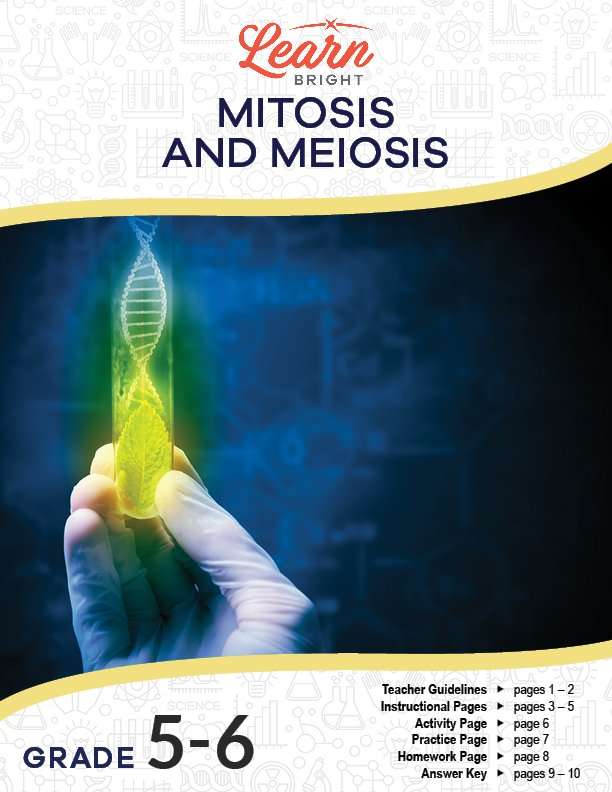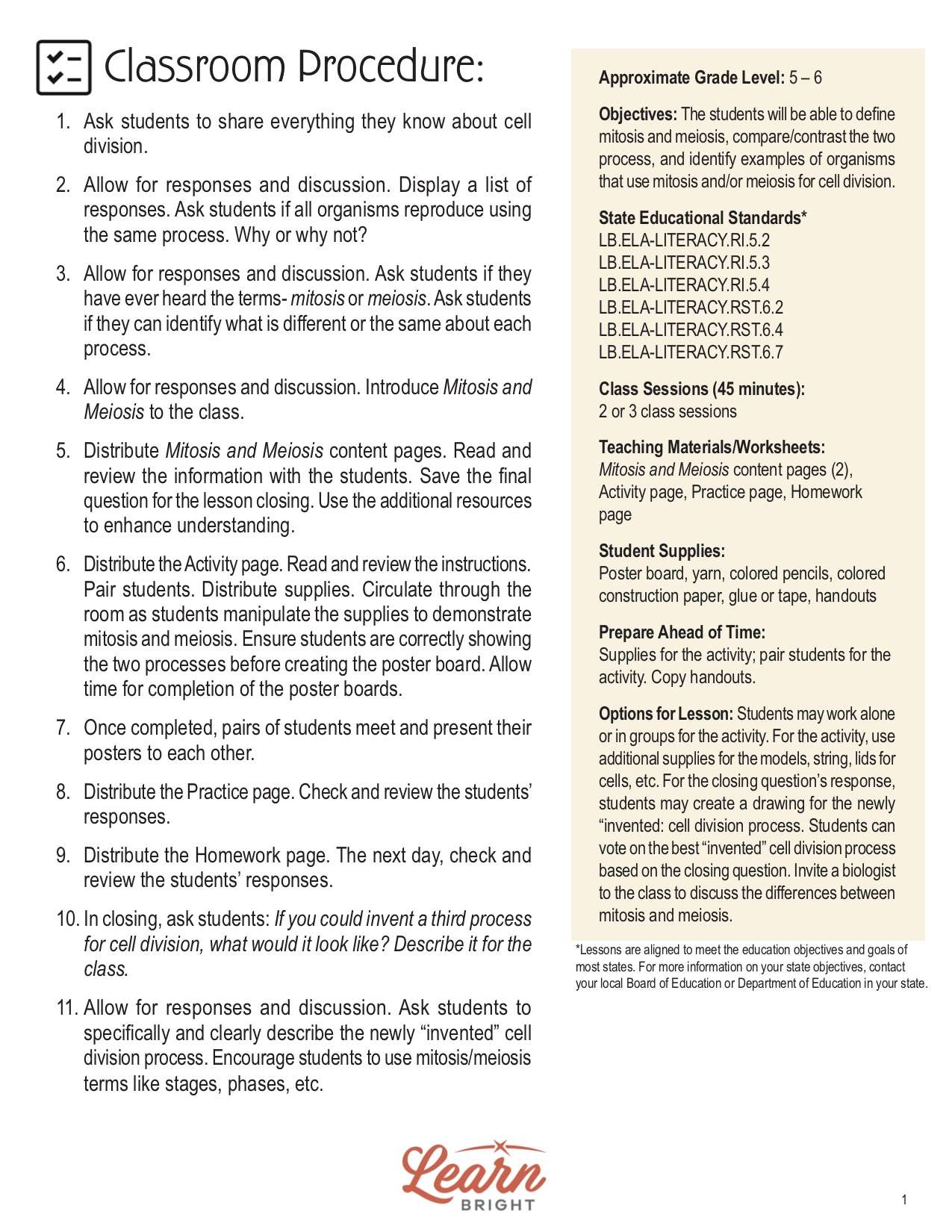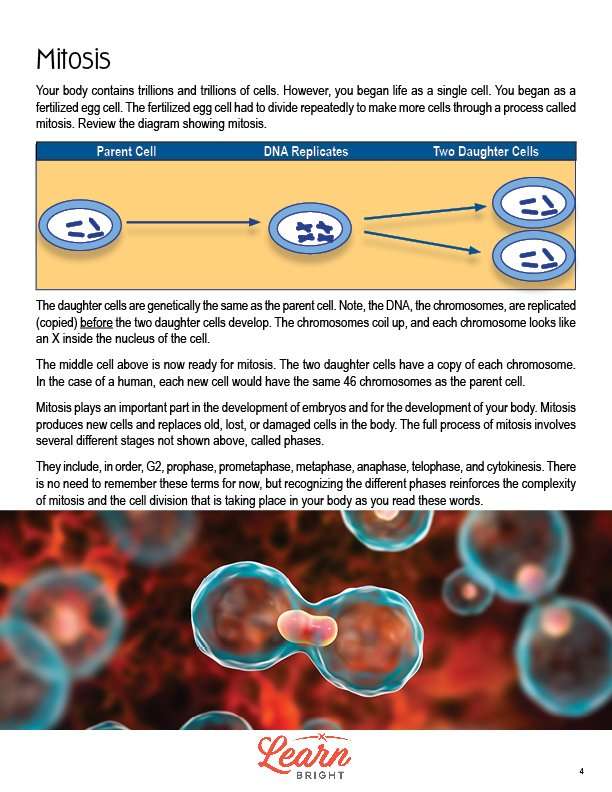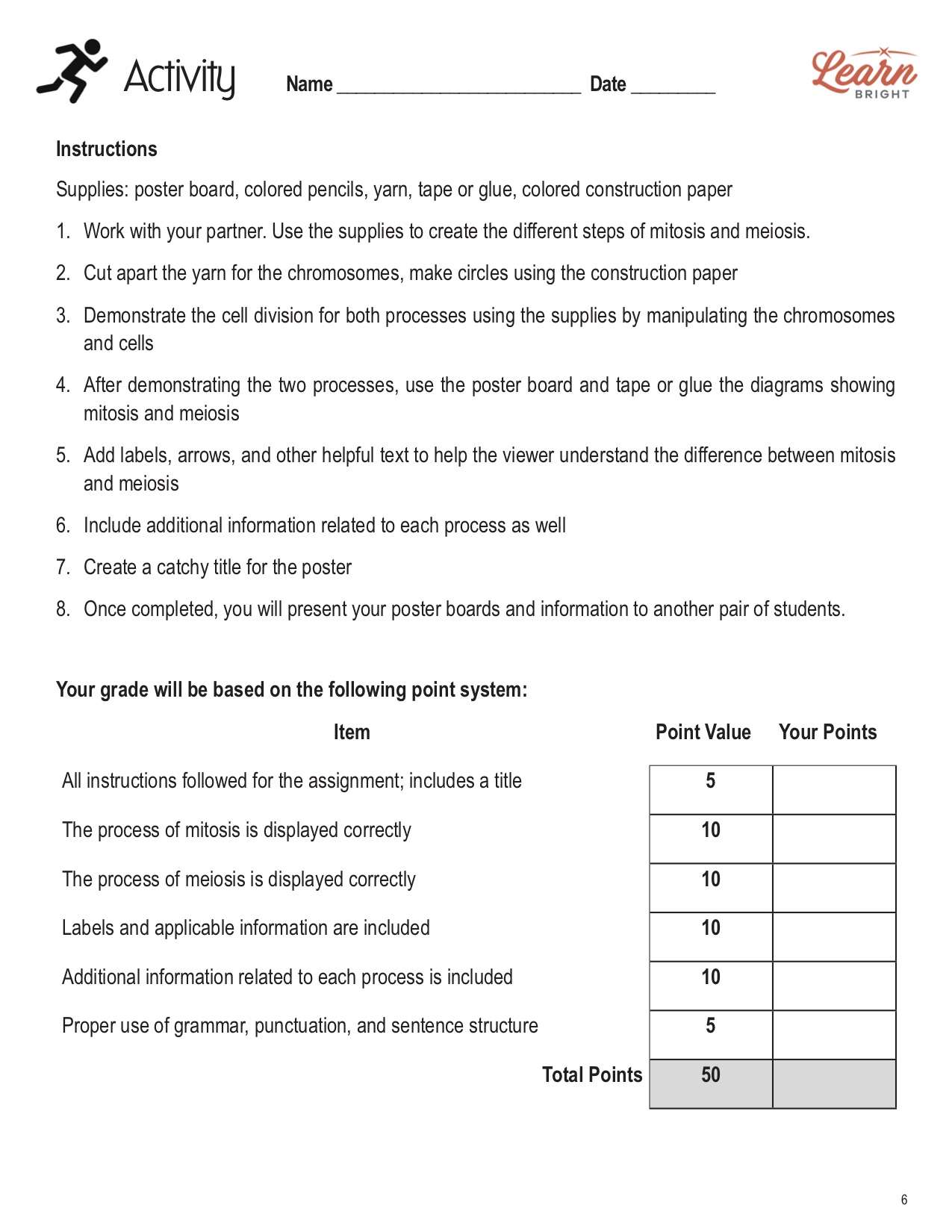Description
What our Mitosis and Meiosis lesson plan includes
Lesson Objectives and Overview: Mitosis and Meiosis teaches students how to identify these two processes of cell division. Students will be able to define the terms and compare and contrast the two. They will also discover the kinds of organisms that use mitosis or meiosis to divide their cells. This lesson is for students in 5th grade and 6th grade.
Classroom Procedure
Every lesson plan provides you with a classroom procedure page that outlines a step-by-step guide to follow. You do not have to follow the guide exactly. The guide helps you organize the lesson and details when to hand out worksheets. It also lists information in the yellow box that you might find useful. You will find the lesson objectives, state standards, and number of class sessions the lesson should take to complete in this area. In addition, it describes the supplies you will need as well as what and how you need to prepare beforehand. In addition to the handouts, you will need to supply poster board, yarn, colored pencils, colored construction paper, and glue or tape.
Options for Lesson
There are a few suggestions in the “Options for Lesson” section that you could incorporate into the lesson if you want. For the activity, you could gather additional items for making the models, such as string, lids for the cells, and so on. An optional addition to the response for the closing question is for students to draw diagrams of the “newly invented” cell division process. Students could then vote on which process is best based on the closing question. A final idea is to invite a biologist to speak to the class and discuss the differences between the two cell division processes.
Teacher Notes
The teacher notes pages provides an extra bit of information about the lesson. Students may know some things about cell division but may not realize that there are different types. You could benefit from teaching this lesson in conjunction with others that relate to biology, cells, and cell division. Use the blank lines to write out the thoughts or ideas you have as you prepare.
MITOSIS AND MEIOSIS LESSON PLAN CONTENT PAGES
Cell Division
The Mitosis and Meiosis lesson plan contains three pages of content. The lesson first reminds students about cell division and why it is so important. This natural process is necessary for the growth and survival of all living things. After all, living things have to reproduce and create offspring so that the species does not die out. Students will discover that cells divide in two different ways. One way is mitosis. One-celled organisms and some plants use this process to reproduce (asexual). The other way is meiosis. Humans and animals use meiosis for reproduction (sexual).
Without cell division, asexual and sexual reproduction would not be possible, nor would cells be able to grow. Skin cells, for instance, die out, but they get replaced through cell division. The same is true for blood, bone, brain, and other cells in the body. Mitosis occurs in asexual reproduction, when all of the organism’s chromosomes copy and create two identical sets of chromosomes. Meiosis occurs in sexual reproduction, when just half the chromosomes from each of two parents pass on to their offspring.
While humans reproduce sexually to create offspring, our bodies experience the process of mitosis when it comes to individual cells. The same is true for most other animals as well. Mitosis occurs within our cells so that they can duplicate. Using the skin cell example, the parent cell divides to form two daughter cells that are exactly the same as the parent skin cell.
Mitosis and Meiosis
Our bodies contain trillions upon trillions of different cells. We began life as a single cell, a fertilized egg cell. That fertilized egg cell had to divide repeatedly to make more and more cells through mitosis. The lesson provides a diagram to demonstrate how this process works. The daughter cells are genetically the same as the parent cell. The DNA or chromosomes, however, replicate before the two daughter cells develop.
Once the DNA replicates, the cell is ready for mitosis. The two daughter cells have a copy of each chromosome. For humans, each new cell would have the same 46 chromosomes as the parent cell. Mitosis plays a very important role in the development of embryos and our bodies overall. The process produces new cells and replaces old, lost, or damaged ones. The full process involves several stages called phases. Those phases are G2, prophase, prometaphase, metaphase, anaphase, telophase, and cytokinesis.
The human body contains 23 pairs of chromosomes, or 46 total. The sperm and egg cells each contain 23 single chromosomes. These are made using the cell division process of meiosis. Meiosis makes these special cells that have half the normal number of chromosomes. The lesson provides another diagram that shows the basic steps of meiosis. There are two cell division stages.
Meiosis I separates the matching pairs of chromosomes. Each daughter cell receives a mix of chromosomes from the two sets in the parent cell. The chromosomes in each pair swap some genetic material before “crossing over.” This process produces new combinations of genes in the sperm or egg cells. In the meiosis II phase, the chromosomes divide into two copies, just like what happens during mitosis.
MITOSIS AND MEIOSIS LESSON PLAN WORKSHEETS
The Mitosis and Meiosis lesson plan includes three worksheets: an activity worksheet, a practice worksheet, and a homework assignment. Each of these handouts helps students’ demonstrate what they learned and solidify their comprehension of the concepts. The guidelines on the classroom procedure page describe when to hand out each one to the class.
DIAGRAM POSTER ACTIVITY
Students can work with a partner to complete this activity. They will need several supplies, listed at the top of the worksheet. Students will create a poster board that displays the steps of both mitosis and meiosis. They will include visuals that they create with the yarn and colored pencils. They will also include labels and other helpful text to help viewers see the difference between the two processes.
MITOSIS, MEIOSIS, OR BOTH PRACTICE WORKSHEET
The practice worksheet is split into two sections. For the first part, students will need to figure out whether statements describe mitosis, meiosis, or both. There are 10 total statements. The second part requires students to label the diagram. There are nine blanks to fill in.
MITOSIS AND MEIOSIS HOMEWORK ASSIGNMENT
Similar to the practice worksheet, there are two sections of the homework assignment. Students will first fill in the blanks in 10 statements using the words in the word bank. Then they will draw a picture that represents meiosis, beginning with the parent cell.
Worksheet Answer Keys
The last two pages of the PDF are answer keys for the practice and homework worksheets. The correct responses are in red to make it easy to compare them to students’ answers. If you choose to administer the lesson pages to your students via PDF, you will need to save a new file that omits these pages. Otherwise, you can simply print out the applicable pages and keep these as reference for yourself when grading assignments.









